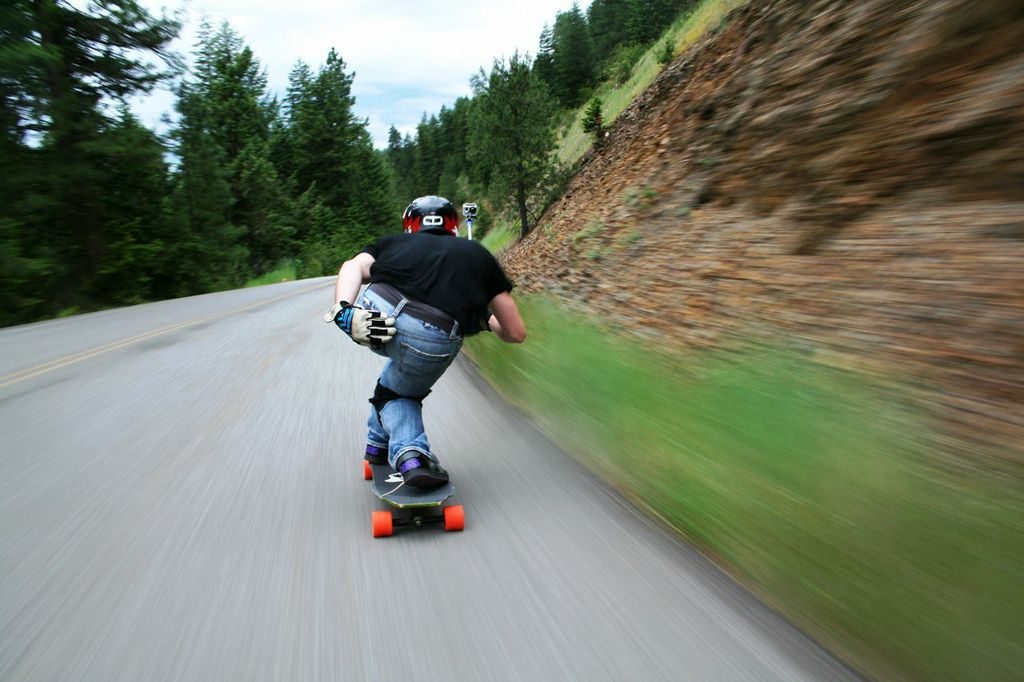A few years back while riding my bike on the Spokane Centennial Trail, I came across a sight that seemed out of sorts to my eyes: Two men, forty-something in appearance, moving at a very high rate of speed, were approaching me. These guys were carving, sliding, and generally looking to be having a ball on what I thought were irregularly long skateboards. Grown adults having fun on skateboards? And giant skateboards no less. I soon began a quest to find out more about what I had witnessed that day. What I discovered was a fascinating off-shoot of the skateboard industry known as “longboarding.”
What exactly is a longboard? A longboard is greater in size (both length and width) than its smaller counterpart, the skateboard, and has more stability, traction and durability due to lower wheel durometers (a measure of the wheel’s hardness). Many, but not all longboards, use trucks (axles) that contain different geometric dimensions than a skateboard as well. The angles at which some longboards can turn, as well as their ability to coast long distances make them more suitable for cruising on streets than regular skateboards.
Longer than a trick-deck skateboard, longboards are usually equipped with larger, softer wheels which afford a smoother, faster ride, or depending on the durometer, it can be a slower ride. Since longboards use softer bushings than a typical skateboard, carving is generally easier too.
Recently, I stopped by Sports Outlet, one of Spokane’s largest skateboard retailers to find some answers to a few of my lingering questions. Jeff Yamada, a sales associate for Sports Outlet, gave me the skinny on modern longboarding. (Editor’s note: Sports Outlet has since closed.)
Why longboarding?
“Basically, longboarding started when people decided that they were going to try to surf on the street,” said Yamada. “The bigger boards used in longboarding have a cruise-like, carving feel with greater travel per kick and more surface area to stand on – it’s more reminiscent of surfing than traditional skateboarding,” he added.
Skateboarding came before longboarding and surfing came before both. Skateboarding originated in Hawaii in 1959. When the surf was low or too rough, surfers would “sidewalk surf” or skateboard. As skateboarding slowly became a popular hobby, it eventually led to the creation of longer boards. Roller-skate wheels were typically used to assemble both long and short boards. Modern longboarding and skateboarding became official in the 1970s when urethane wheels were finally invented.

Anatomy of a longboard
The board is essentially characterized by 4 components: the shape of the deck; the wood type; the truck style; and the wheels’ size, shape, and hardness. “For beginners, I would recommend a pintail shape (narrow towards the rear) with reverse kingpin trucks (kingpin is on the outside) with softer wheels in the 75-80 durometer range,” Yamada said. The pintail shape is easy to control, and the softer wheels provide greater grip on the pavement,” he added.
What about wood types? “That’s personal preference,” Yamada said. “Some like the springy feel of bamboo while others like the stiffer feel of maple”.
Places to ride
Longboarding can generally be done anywhere there is pavement, but for the best riding experience Yamada recommended newer asphalt trails such as his personal favorite, The Centennial Trail. Other similar trails include: Fish Lake Trail and Medical Lake Trail – and for a more urban experience, he recommended Riverfront Park or City Park in Coeur d’Alene.
Safety
While longboarding is a fairly safe activity, most injuries occur when riders attempt to “slide-brake” while moving at high rates of speed. Before learning proper braking techniques, it is also common for riders to jump off the moving board and ‘run out’ their speed, but this is safe only at low speeds.
“I see a lot of newer riders pushing it until the board begins to speed wobble – the rider starts gaining speed, the board starts shaking and the rider will jump off,” Yamada said. This technique is considered dangerous among the longboarding community. If the rider is traveling faster than the speed at which they can run, other techniques are required, such as foot-braking or carefully controlled sliding maneuvers.
He also recommended wearing helmets, knee pads and wrist guards or sliding gloves. “You name it, and I’ve scraped it up – the more protection you have the better.”
Just how fast do these boards go?
Longboards travel at a much faster rate of speed than traditional skateboards. Some boards, like the ones designed by David Uhlenkott at Dopamine Sports in Spokane, are designed to travel at speeds beyond forty miles per hour. “For me it’s all about the speed and the only way to get that fix is on a longboard,” Uhlenkott said.
While skateboarding may have the stereotype as a youth driven sport, longboarding seems to have developed a greater appeal to a larger age group. Manufacturers are marketing boards to people from the ages of 10 all the way up to 50. It seems that the ease of use combined with the diversity of riding locations has given many of those “grown adults” a chance to relive their youthful skateboarding days and also given them the chance to create some new and even better memories on their longboards.
Originally published in the September 2013 issue of “Out There Monthly.”
[Updated online May 2021; Editor’s note: Sports Outlet and Dopamine Board Sports have since closed.]
[Feature photo courtesy of David Uhlenkott, Dopamine Board Sports.]













